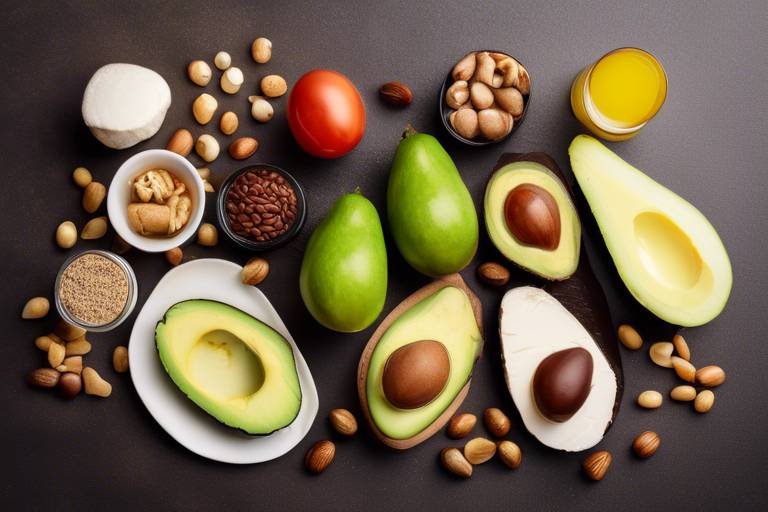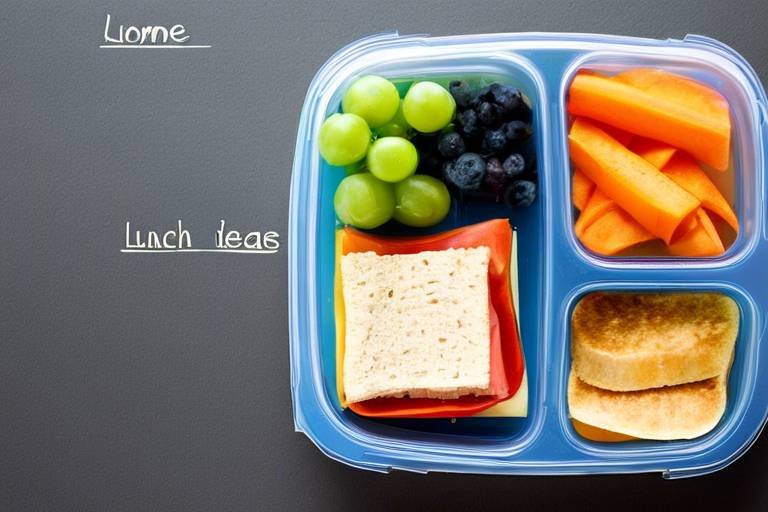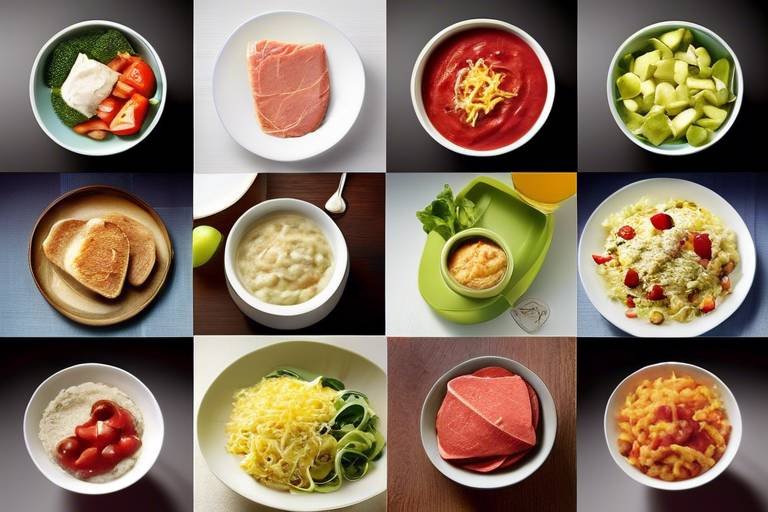The Role of Healthy Fats in Your Family's Diet
In today's fast-paced world, where convenience often trumps nutrition, it’s easy to overlook the importance of healthy fats in our family's diet. But what if I told you that these fats are not just a source of energy but also play a pivotal role in maintaining our health? Understanding the significance of healthy fats can transform the way we view food and nutrition. They are essential for growth, development, and overall well-being. So, let’s dive into the fascinating world of healthy fats and discover how they can enhance your family's meals!
When we talk about fats, it's crucial to distinguish between the different types: saturated fats, unsaturated fats, and trans fats. Each type affects our health in unique ways. Saturated fats, often found in animal products and some plant oils, can raise cholesterol levels if consumed excessively. On the other hand, unsaturated fats, which include both monounsaturated and polyunsaturated fats, are known as the "good" fats. They can actually help lower bad cholesterol levels and provide essential fatty acids that our bodies can't produce on their own. Lastly, trans fats, commonly found in processed foods, should be avoided as they contribute to various health issues. Understanding these differences is the first step in making better dietary choices for your family.
Incorporating healthy fats into your diet is not just a trend; it comes with a plethora of benefits. For starters, these fats are vital for heart health, brain function, and even nutrient absorption. Imagine your body as a car: just as you wouldn't fuel your vehicle with low-quality gas, you shouldn't skimp on the quality of fats you consume. Healthy fats act as high-octane fuel, powering your body with the energy and nutrients it needs to function optimally. Let’s explore these benefits more closely.
One of the standout benefits of healthy fats is their ability to support heart health. They can help lower bad cholesterol levels, which reduces the risk of heart disease. Think of healthy fats as the protective shield for your heart. Foods rich in omega-3 fatty acids, such as fish, flaxseeds, and walnuts, are excellent choices. These fats not only promote a healthy heart but also help combat inflammation. To ensure your family gets enough omega-3s, consider adding these foods to your weekly meal plan.
Omega-3 fatty acids are crucial for maintaining heart health. They can be found in:
- Fatty fish: Salmon, mackerel, and sardines
- Plant-based sources: Flaxseeds, chia seeds, and walnuts
- Algal oil: A great vegan source of omega-3s
Incorporating these foods into your family meals can be as simple as preparing a delicious salmon dinner or adding flaxseeds to your morning smoothie.
Another group of healthy fats is monounsaturated fats, found in foods like olive oil, avocados, and nuts. These fats are known for their heart-healthy benefits, helping to reduce bad cholesterol levels while raising good cholesterol. Think of them as the secret ingredient that can elevate your family’s meals. Drizzle olive oil on salads, mash avocados on whole-grain toast, or snack on a handful of nuts to reap the benefits of these delicious fats.
Healthy fats are not just good for the heart; they also play a vital role in supporting brain health. Our brains are made up of nearly 60% fat, and consuming the right types of fats can enhance cognitive function and mood regulation. Imagine your brain as a high-performance computer; without the right software (in this case, healthy fats), it won’t run efficiently. By including healthy fats in your family's diet, you can help improve focus, memory, and overall mental well-being.
Now that we’ve established the importance of healthy fats, the question arises: how can we incorporate them into our daily meals? The answer is simpler than you might think! Adding healthy fats can be both easy and delicious. Start by choosing the right cooking oils, such as olive oil or avocado oil, for your cooking needs. These oils not only enhance the flavor of your dishes but also boost their nutritional value.
When it comes to cooking with healthy fats, here are a few tips to keep in mind:
- Use olive oil for sautéing vegetables or drizzling over salads.
- Incorporate avocados into sandwiches or smoothies for a creamy texture.
- Opt for nuts and seeds as snacks or toppings for yogurt and salads.
By making these small changes, you can significantly increase the healthy fat content of your meals.
Looking for ways to make healthy fats appealing to your family? Here are a couple of easy recipes:
1. **Avocado Toast**: - Whole-grain bread topped with smashed avocado, a sprinkle of salt, and a drizzle of olive oil. 2. **Walnut Pesto Pasta**: - Blend walnuts, basil, garlic, and olive oil for a nutty twist on traditional pesto, served over whole-grain pasta.
These recipes are not only nutritious but also guaranteed crowd-pleasers!
1. What are the best sources of healthy fats?
The best sources include fatty fish, avocados, nuts, seeds, and olive oil.
2. How can I tell if a fat is healthy?
Healthy fats are typically unsaturated fats, while saturated and trans fats should be limited.
3. Can I consume too much healthy fat?
Yes, while healthy fats are beneficial, moderation is key. Balance them with other nutrients in your diet.
4. Are there any specific dietary recommendations for children?
Children need healthy fats for growth and brain development, so include sources like fish and avocados in their meals.

Understanding Healthy Fats
When we talk about fats, it's easy to get lost in the confusion of what’s good and what’s bad. But let’s clear the air: healthy fats are not just a trendy buzzword; they are essential for your family's overall well-being. To understand healthy fats, we need to break them down into three main categories: saturated fats, unsaturated fats, and trans fats. Each type plays a different role in our health, and knowing the differences can help you make informed dietary choices.
Saturated fats are typically solid at room temperature and can be found in animal products like butter, cheese, and fatty meats. While they are not all bad, consuming them in moderation is crucial. Too much saturated fat can lead to an increase in bad cholesterol levels, which is linked to heart disease. On the flip side, unsaturated fats are often liquid at room temperature and are considered the healthier option. They are divided into two categories: monounsaturated fats and polyunsaturated fats. Monounsaturated fats, found in foods like olive oil and avocados, are known for their heart-healthy benefits. Polyunsaturated fats include omega-3 and omega-6 fatty acids, which are vital for brain function and overall health.
Now, let’s talk about trans fats. These are the bad guys in the fat family. Often found in processed foods and baked goods, trans fats can raise bad cholesterol levels while lowering good cholesterol levels, making them a major risk factor for heart disease. It's best to avoid these as much as possible, so always check food labels!
To make this clearer, here’s a quick comparison:
| Type of Fat | Sources | Health Impact |
|---|---|---|
| Saturated Fats | Butter, cheese, red meat | Can raise bad cholesterol; consume in moderation |
| Unsaturated Fats | Olive oil, nuts, fish | Heart-healthy; lowers bad cholesterol |
| Trans Fats | Processed snacks, fried foods | Raises bad cholesterol; should be avoided |
Understanding these different types of fats is the first step towards a healthier diet. By incorporating more unsaturated fats and being mindful of saturated and trans fats, you can create a balanced diet that supports your family’s health. Remember, it’s not just about cutting out the bad; it’s equally important to include the good!

Benefits of Healthy Fats
Incorporating healthy fats into your diet is not just a trend; it's a crucial step towards a healthier lifestyle for your entire family. These fats are packed with benefits that can enhance your overall well-being. From improving heart health to boosting brain function, healthy fats play a vital role in maintaining a balanced diet. But what exactly are these benefits? Let's dive deeper!
One of the most significant advantages of healthy fats is their ability to improve heart health. Unlike saturated and trans fats, which can raise bad cholesterol levels and increase the risk of heart disease, healthy fats can actually lower bad cholesterol (LDL) and raise good cholesterol (HDL). This means that incorporating healthy fats into your meals can lead to a healthier heart and a lower risk of cardiovascular issues. Foods rich in omega-3 fatty acids, such as salmon, walnuts, and flaxseeds, are excellent choices that can help support your heart.
Additionally, healthy fats are essential for brain function. Our brains are composed of approximately 60% fat, and consuming the right types of fats can enhance cognitive function and mood regulation. Omega-3 fatty acids, in particular, are known to play a crucial role in brain health. They help improve memory, reduce the risk of cognitive decline, and even support mental health by combating depression and anxiety. By including healthy fats in your family's diet, you're not just feeding their bodies; you're nourishing their minds!
Another incredible benefit of healthy fats is their ability to enhance nutrient absorption. Certain vitamins, such as A, D, E, and K, are fat-soluble, meaning they need fat to be properly absorbed by the body. By incorporating healthy fats into meals, you can ensure that your family is getting the most out of their food. For example, adding a drizzle of olive oil to a salad not only enhances the flavor but also helps your body absorb the essential nutrients from the vegetables.
To summarize the benefits of healthy fats, consider the following key points:
- Heart Health: Lower bad cholesterol and reduce heart disease risk.
- Brain Function: Enhance cognitive function and mood regulation.
- Nutrient Absorption: Improve the absorption of fat-soluble vitamins.
Incorporating healthy fats into your family's diet can be a game-changer. Not only do they provide essential nutrients, but they also make meals more satisfying and delicious. So, the next time you're planning your family's meals, remember the importance of including these beneficial fats. Your family will thank you for it!
1. What are healthy fats?
Healthy fats are types of fats that are beneficial for your body, including monounsaturated and polyunsaturated fats, such as those found in olive oil, avocados, nuts, and fatty fish.
2. How can I incorporate healthy fats into my family's diet?
You can add healthy fats by using olive oil in salad dressings, including avocados in sandwiches, snacking on nuts, or serving fatty fish like salmon a couple of times a week.
3. Are all fats bad for health?
Not all fats are bad. While trans fats and excessive saturated fats can be harmful, healthy fats are essential for overall health and should be included in a balanced diet.

Heart Health
When it comes to keeping our hearts in tip-top shape, the types of fats we consume play a pivotal role. You might be wondering, “How can something as simple as fat impact my heart?” Well, it’s all about the kind of fats we choose to include in our diets. Healthy fats can actually lower bad cholesterol levels and significantly reduce the risk of heart disease. Imagine your heart as a finely tuned engine; just like you wouldn’t fuel it with poor-quality gasoline, you shouldn’t fuel your body with unhealthy fats.
So, what are these healthy fats that we keep hearing about? They primarily fall into two categories: monounsaturated fats and polyunsaturated fats. Monounsaturated fats, found in foods like olive oil, avocados, and nuts, help to lower bad cholesterol (LDL) while raising good cholesterol (HDL). On the other hand, polyunsaturated fats include omega-3 and omega-6 fatty acids, which are crucial for heart health.
To put it simply, think of your heart as a garden. Just as a garden thrives with the right nutrients and care, your heart flourishes with the right fats. Here’s how these healthy fats contribute to a healthy heart:
- Lowering Cholesterol: Healthy fats help to manage cholesterol levels effectively, which reduces the risk of plaque buildup in arteries.
- Reducing Inflammation: Omega-3 fatty acids, in particular, have anti-inflammatory properties that can help protect against heart disease.
- Improving Blood Vessel Function: Healthy fats can enhance the function of blood vessels, promoting better circulation.
Now, you might be curious about where to find these heart-friendly fats. Here are some of the best sources to include in your family’s meals:
| Type of Fat | Sources | Benefits |
|---|---|---|
| Monounsaturated Fats | Olive oil, avocados, nuts | Lower bad cholesterol, reduce heart disease risk |
| Omega-3 Fatty Acids | Fatty fish (salmon, mackerel), flaxseeds, walnuts | Reduce inflammation, improve heart health |
| Polyunsaturated Fats | Sunflower oil, corn oil, soybeans | Lower cholesterol levels, support heart function |
Incorporating these healthy fats into your diet doesn’t have to be a chore. You can easily swap out less healthy options for these heart-healthy alternatives. For instance, try drizzling olive oil on your salads instead of using creamy dressings, or enjoy a handful of nuts as a snack rather than reaching for chips. Remember, it’s all about making small, manageable changes that can lead to big benefits for your heart health.
Ultimately, embracing healthy fats is not just a dietary choice; it’s a lifestyle change that can have lasting benefits for you and your family. By prioritizing these fats, you’re investing in your heart’s future, ensuring that it remains strong and healthy for years to come. So, next time you’re at the grocery store, think about your heart and the types of fats you’re choosing to bring home. Your heart will thank you!

Sources of Omega-3 Fatty Acids
When it comes to nourishing your family, Omega-3 fatty acids are like the superheroes of the fat world. These essential fats are vital for maintaining good health, yet our bodies can't produce them on their own. So, where can we find these mighty nutrients? Let's dive into some of the best sources that can easily be integrated into your family's meals.
First up, we have fatty fish. Think salmon, mackerel, sardines, and trout. These fish are not only delicious but are also packed with Omega-3s. A simple grilled salmon fillet can be a hit at dinner, and it’s a fantastic way to get your family excited about healthy eating. Plus, it’s a great excuse to gather around the table and enjoy a meal together.
But wait, if your family isn’t keen on fish, don’t fret! There are plenty of plant-based sources to consider. Flaxseeds and chia seeds are excellent options. Just a tablespoon of ground flaxseeds sprinkled on your morning yogurt or blended into a smoothie can provide a hearty dose of Omega-3s. You could even sneak them into your baking—think muffins or pancakes! And let’s not forget about walnuts; they’re not just a snack but a powerhouse of nutrition. Toss a handful into a salad or mix them into your oatmeal for a crunchy, healthful boost.
Now, if you’re looking for something a bit different, consider algal oil. This is derived from algae and is a fantastic vegan source of Omega-3s. It's available in supplement form, making it a convenient option for those who want to ensure they’re getting enough of these essential fats without the fishy taste.
To put it all together, here’s a quick table summarizing some of the top sources of Omega-3 fatty acids:
| Source | Type of Omega-3 | Serving Suggestions |
|---|---|---|
| Fatty Fish (e.g., salmon, mackerel) | EPA and DHA | Grilled, baked, or in sushi |
| Flaxseeds | ALA | Ground in smoothies or sprinkled on yogurt |
| Chia Seeds | ALA | Soaked in water or added to puddings |
| Walnuts | ALA | As a snack or in salads |
| Algal Oil | DHA | As a supplement |
Incorporating these sources into your family’s diet can be both fun and delicious. Imagine a family dinner featuring a zesty salmon dish, or a weekend breakfast with chia seed pudding topped with fresh fruit. With a little creativity, you can make Omega-3s a delightful part of your daily meals!
Q: How often should we eat Omega-3 rich foods?
A: Aim for at least two servings of fatty fish per week, along with other sources like nuts and seeds daily.
Q: Can I get enough Omega-3s if I don’t eat fish?
A: Absolutely! Incorporate flaxseeds, chia seeds, walnuts, and consider algal oil supplements for a plant-based approach.
Q: What are the health benefits of Omega-3 fatty acids?
A: Omega-3s are known to support heart health, improve brain function, and reduce inflammation, making them essential for overall well-being.

Monounsaturated Fats
When it comes to healthy eating, are like the shining stars of the fat world. These fats are not only delicious but also incredibly beneficial for your health. Found in foods like olive oil, avocados, and nuts, they have been shown to improve heart health and support overall well-being. Imagine your body as a high-performance car; just like premium fuel keeps your engine running smoothly, monounsaturated fats provide the essential energy and nutrients your body needs to function at its best.
One of the standout features of monounsaturated fats is their ability to lower bad cholesterol levels (LDL) while raising good cholesterol (HDL). This balance is crucial because high levels of LDL can lead to heart disease. By incorporating these healthy fats into your family's diet, you can help reduce the risk of cardiovascular issues. For instance, replacing butter with olive oil in cooking not only enhances flavor but also significantly boosts the health quotient of your meals.
Another fantastic aspect of monounsaturated fats is their role in weight management. Contrary to the common misconception that all fats contribute to weight gain, healthy fats can actually help you feel fuller for longer, reducing the urge to snack on unhealthy options. Think of it this way: when you enjoy a meal rich in monounsaturated fats, like a salad topped with avocado and a drizzle of olive oil, you're nourishing your body while keeping hunger at bay.
To make the most of these healthy fats, consider some simple yet effective ways to incorporate them into your family's meals:
- Add slices of avocado to sandwiches or salads for a creamy texture and rich flavor.
- Use olive oil as a base for salad dressings or marinades, mixing it with vinegar and herbs for a tasty twist.
- Snack on a handful of nuts, such as almonds or cashews, for a quick energy boost.
In summary, embracing monounsaturated fats in your family's diet is not just a trend; it's a lifestyle choice that can lead to long-term health benefits. By making small changes, like opting for avocado instead of cheese or using olive oil for cooking, you can create meals that are not only nutritious but also bursting with flavor. So, why not start today? Your taste buds and your heart will thank you!
1. What are some good sources of monounsaturated fats?
Some excellent sources include olive oil, avocados, nuts (like almonds and hazelnuts), and seeds. Incorporating these into your meals can significantly boost your intake of healthy fats.
2. Can monounsaturated fats help with weight loss?
Yes! Monounsaturated fats can help you feel fuller for longer, which may reduce overall calorie intake. When consumed in moderation, they can be part of a healthy weight management plan.
3. How can I incorporate more monounsaturated fats into my diet?
Start by using olive oil in cooking and salad dressings, enjoy avocados on toast, and snack on nuts instead of chips. These small changes can make a big difference!

Brain Function
When it comes to our brain health, healthy fats are nothing short of superheroes. They play a crucial role in maintaining cognitive function and enhancing our mood. Think of your brain as a high-performance engine; just like any engine needs the right fuel to run efficiently, your brain thrives on specific types of fats. These fats are not just an afterthought; they are essential building blocks that support everything from memory retention to emotional stability.
One of the key players in this arena is the omega-3 fatty acid. Found abundantly in fatty fish like salmon, mackerel, and sardines, omega-3s are renowned for their ability to promote brain health. They help in forming the structure of brain cells and are crucial for communication between these cells. Studies have shown that a diet rich in omega-3s can lead to improved memory and reduced risk of cognitive decline as we age. Imagine your brain being like a well-oiled machine; with omega-3s, you're ensuring that every cog and wheel is functioning smoothly.
But omega-3s are just the tip of the iceberg when it comes to healthy fats. Monounsaturated fats, found in foods like avocados and olive oil, also contribute significantly to brain health. These fats help to reduce inflammation and oxidative stress, which are known to impact cognitive abilities negatively. By incorporating these fats into your meals, you're not only making them tastier but also giving your brain the nourishment it needs to operate at its best.
Furthermore, healthy fats are vital for the production of neurotransmitters, the chemicals that transmit signals in the brain. Without adequate healthy fats, your body may struggle to produce these essential chemicals, leading to mood swings and cognitive dysfunction. It's like trying to run a high-tech computer without the necessary software updates; things just won't work as efficiently.
To truly harness the benefits of healthy fats for brain function, consider incorporating the following foods into your family's diet:
- Fatty Fish: Salmon, trout, and sardines are rich in omega-3s.
- Nuts and Seeds: Walnuts and flaxseeds are excellent sources of healthy fats.
- Avocados: Packed with monounsaturated fats, they can be added to salads, sandwiches, or smoothies.
- Olive Oil: Use it as a dressing or for cooking to reap its brain-boosting benefits.
In summary, incorporating healthy fats into your family's diet is not just a trend; it's a necessity for maintaining optimal brain function. By choosing the right fats, you can enhance cognitive abilities, improve mood, and support overall mental well-being. So next time you're planning a meal, think about how you can fuel your family's brains with the power of healthy fats!
1. What are some good sources of omega-3 fatty acids?
Omega-3 fatty acids can be found in fatty fish such as salmon and sardines, as well as in flaxseeds, chia seeds, and walnuts.
2. How do healthy fats improve brain function?
Healthy fats support the structure of brain cells, enhance communication between them, and help in the production of neurotransmitters, which are vital for mood regulation and cognitive function.
3. Can I get enough healthy fats from a vegetarian diet?
Absolutely! Vegetarians can obtain healthy fats from sources like avocados, nuts, seeds, and plant-based oils such as olive oil and flaxseed oil.
4. Is there such a thing as too much fat in the diet?
While healthy fats are beneficial, moderation is key. It's important to balance your fat intake with other nutrients to maintain a well-rounded diet.

Incorporating Healthy Fats into Meals
Adding healthy fats to your family's diet can be both simple and delicious. Imagine transforming ordinary meals into nutritional powerhouses with just a few tweaks! It’s not just about slapping on a layer of avocado or drizzling olive oil; it’s about making conscious choices that benefit everyone at the table. So, how do we seamlessly weave these healthy fats into our daily meals? Let’s dive into some practical tips and creative ideas that will make your family excited about eating well.
First off, consider the cooking oils you use. Instead of reaching for the vegetable oil, why not try extra virgin olive oil? This oil is not only rich in monounsaturated fats but also packed with antioxidants. Use it for sautéing vegetables, drizzling over salads, or even as a dip for whole-grain bread. When cooking at high temperatures, opt for oils with higher smoke points, like avocado oil or coconut oil, which can withstand the heat while retaining their health benefits.
Incorporating healthy fats doesn’t stop at cooking oils. Think about adding nuts and seeds to your meals. They are fantastic sources of omega-3 fatty acids and can easily be sprinkled over salads, blended into smoothies, or mixed into yogurt. Not only do they add a delightful crunch, but they also provide essential nutrients that can help keep your family feeling full and satisfied. For instance, a handful of walnuts or a sprinkle of chia seeds can elevate a simple dish to a whole new level of healthiness.
Another great way to enrich your meals with healthy fats is through avocados. These creamy delights can be used in a variety of ways, from guacamole to avocado toast, or even sliced in salads. They’re incredibly versatile and can be added to smoothies for a creamy texture without overpowering the flavor. Plus, kids love them, making it a win-win situation!
Don’t forget about incorporating fatty fish into your weekly meal plan. Fish such as salmon, mackerel, and sardines are loaded with omega-3s, which are crucial for heart and brain health. Aim to include fish in your family’s diet at least twice a week. You can grill, bake, or even make fish tacos for a fun and healthy dinner option. Here’s a quick recipe idea:
Simple Baked Salmon Recipe: 1. Preheat your oven to 400°F (200°C). 2. Place salmon fillets on a baking sheet. 3. Drizzle with olive oil, lemon juice, salt, and pepper. 4. Bake for 12-15 minutes until cooked through. 5. Serve with a side of steamed veggies and quinoa.
Lastly, let’s not overlook dairy products! Opt for full-fat dairy options like yogurt and cheese. They contain healthy fats that can help with nutrient absorption and keep your family feeling full longer. Try using full-fat Greek yogurt as a base for smoothies or as a topping for fruit. It’s a delicious way to sneak in those healthy fats while enjoying a tasty treat.
In summary, incorporating healthy fats into your family's meals is not only beneficial but can also be incredibly enjoyable. By making small changes in your cooking methods and ingredient choices, you can create delicious dishes that everyone will love. Remember, it’s all about balance and making healthier choices without sacrificing flavor. So, get creative in the kitchen and watch your family thrive on these nutritious additions!
- What are healthy fats? Healthy fats include monounsaturated and polyunsaturated fats, which can be found in foods like avocados, nuts, seeds, and fatty fish.
- How can I tell if a fat is healthy? Look for fats that are liquid at room temperature, such as olive oil, and avoid trans fats, which are often found in processed foods.
- How much healthy fat should I include in my diet? It’s generally recommended that 20-35% of your daily caloric intake comes from healthy fats, but individual needs may vary.

Cooking Tips
When it comes to incorporating healthy fats into your family's meals, understanding how to cook with them can make all the difference. It’s not just about adding a splash of oil or a dollop of butter; it’s about making informed choices that enhance both flavor and nutrition. One of the first things to consider is the type of cooking oil you use. Oils like extra virgin olive oil and avocado oil are excellent choices due to their high levels of monounsaturated fats, which are known to promote heart health. On the other hand, oils such as canola and grapeseed oil, while often marketed as healthy, can be highly processed and less beneficial.
Moreover, the method of cooking plays a crucial role in preserving the integrity of these healthy fats. For instance, when sautéing vegetables, try to use low to medium heat. High temperatures can cause healthy oils to break down and lose their beneficial properties. Instead, consider roasting or baking, which allows you to use oils more effectively without compromising their health benefits. Remember, a little goes a long way; just a tablespoon can add a rich flavor and a nutrient boost to your dishes.
In addition to oils, don’t overlook the potential of other healthy fats such as nuts, seeds, and avocados. These ingredients can be easily added to salads, smoothies, or even as toppings for your favorite dishes. For example, sprinkling some chia seeds or walnuts on a salad not only increases the nutritional value but also adds a delightful crunch. If you're looking for a creamy texture, try blending avocado into your dressings or dips, which can replace less healthy options like mayonnaise.
To help you visualize how to effectively use healthy fats in your cooking, here’s a simple table summarizing some healthy cooking oils and their best uses:
| Cooking Oil | Best Uses | Health Benefits |
|---|---|---|
| Extra Virgin Olive Oil | Salads, sautéing, drizzling | Rich in antioxidants and monounsaturated fats |
| Avocado Oil | High-heat cooking, baking | Supports heart health and has a high smoke point |
| Coconut Oil | Baking, frying | Contains medium-chain triglycerides (MCTs) that may boost metabolism |
| Flaxseed Oil | Dressings, smoothies (do not heat) | High in omega-3 fatty acids |
By following these cooking tips, you can ensure that your family not only enjoys delicious meals but also reaps the numerous health benefits that come from incorporating healthy fats into your diet. Remember, cooking should be a joyful experience, so experiment with different oils and ingredients to find what your family loves best!
Q: What are the best sources of healthy fats?
A: Some of the best sources include avocados, nuts, seeds, olive oil, and fatty fish like salmon.
Q: Can I use butter instead of healthy fats?
A: While butter can be enjoyed in moderation, it's best to opt for healthier alternatives like olive or avocado oil for daily cooking.
Q: How can I make my meals more flavorful with healthy fats?
A: Use flavored oils, such as infused olive oils, or incorporate nuts and seeds to add texture and taste to your dishes.

Family-Friendly Recipes
When it comes to feeding your family, the challenge often lies in balancing nutrition with taste. Fortunately, incorporating healthy fats into your meals can be both simple and delicious! Here are a few family-friendly recipes that not only highlight the benefits of healthy fats but also promise to please even the pickiest eaters.
First up is a creamy avocado pasta. This dish offers a delightful twist on traditional pasta, using ripe avocados as a base for the sauce. Simply blend ripe avocados with garlic, lemon juice, olive oil, and a pinch of salt until smooth. Toss this creamy mixture with your favorite pasta, and top it with cherry tomatoes and fresh basil. Not only does this meal deliver healthy monounsaturated fats, but it also provides essential nutrients and a burst of flavor!
Next, let’s dive into a salmon and quinoa bowl. Salmon is an excellent source of omega-3 fatty acids, which are crucial for heart health. To prepare, grill or bake salmon fillets seasoned with lemon and herbs. Serve them over a bed of fluffy quinoa, which is rich in protein and fiber. Add a mix of colorful vegetables like spinach, bell peppers, and cucumbers, and drizzle with a simple olive oil and balsamic vinegar dressing. This bowl is not just a feast for the eyes but also a powerhouse of nutrition!
If you're looking for a snack that the kids will love, try making energy balls. Combine rolled oats, nut butter, honey, and add-ins like dark chocolate chips or dried fruit. Roll the mixture into small balls and refrigerate. These bites are packed with healthy fats from the nut butter and are perfect for a quick energy boost after school or before sports practice. Plus, they’re so easy to make that the kids can help out in the kitchen!
Lastly, consider a chickpea salad that can double as a side dish or a light meal. Mix canned chickpeas with diced cucumbers, tomatoes, red onion, and parsley. Dress it with olive oil, lemon juice, salt, and pepper for a refreshing taste. Chickpeas are not only a great source of protein but also provide healthy fats, making this salad both nutritious and satisfying.
These recipes are just the beginning! The key is to experiment and find combinations that your family enjoys. Remember, incorporating healthy fats doesn’t mean sacrificing flavor. In fact, it can enhance the taste of your meals while providing essential nutrients that support your family’s health.
- What are healthy fats?
Healthy fats include unsaturated fats, such as those found in olive oil, avocados, and nuts, and omega-3 fatty acids found in fish and flaxseeds. They are essential for heart health, brain function, and overall wellness. - How can I tell if a fat is healthy?
Look for fats that are liquid at room temperature, like olive oil, and avoid trans fats, which are often found in processed foods. Reading labels can help you make informed choices. - Can kids eat healthy fats?
Absolutely! Healthy fats are important for children's growth and development. Just make sure to balance their intake with other nutrients.
Frequently Asked Questions
- What are healthy fats and why are they important?
Healthy fats are essential nutrients that support overall well-being. They play a crucial role in heart health, brain function, and the absorption of vitamins. Unlike unhealthy fats, which can contribute to various health issues, healthy fats help maintain energy levels and keep your family feeling their best.
- What types of healthy fats should I include in my family's diet?
There are several types of healthy fats, including monounsaturated fats, polyunsaturated fats, and omega-3 fatty acids. Foods rich in healthy fats include olive oil, avocados, nuts, seeds, and fatty fish like salmon. Incorporating these into your meals can enhance both flavor and nutrition.
- How can I tell the difference between healthy and unhealthy fats?
Healthy fats are typically liquid at room temperature and come from plant sources or fish, while unhealthy fats are often solid and found in processed foods. Look for fats that are unrefined and minimally processed, such as extra virgin olive oil or natural nut butters, to ensure you're choosing the healthiest options.
- Can healthy fats help with weight management?
Absolutely! Healthy fats can promote satiety, meaning they help you feel full longer. This can prevent overeating and assist in weight management. Including healthy fats in balanced meals can also help maintain stable energy levels throughout the day.
- What are some easy ways to incorporate healthy fats into meals?
There are plenty of simple ways to add healthy fats to your family's diet. You can drizzle olive oil over salads, add avocado to sandwiches, snack on nuts, or include fatty fish in your weekly meal plan. Experimenting with different recipes can make it fun and delicious!
- Are there any risks associated with consuming healthy fats?
While healthy fats are beneficial, moderation is key. Even healthy fats can contribute to excess calorie intake if consumed in large amounts. It's important to balance your fat intake with other food groups to maintain a well-rounded diet.



















